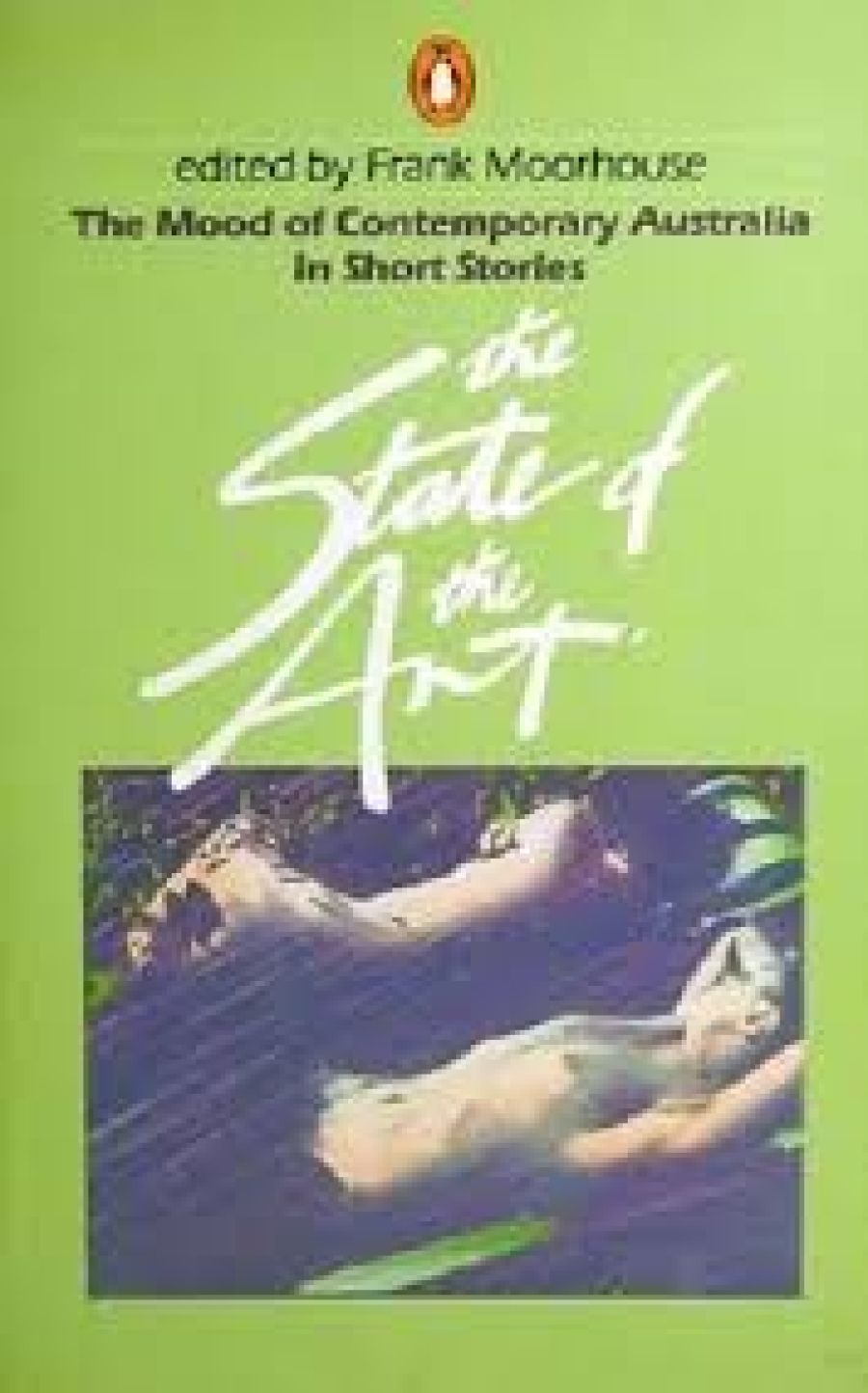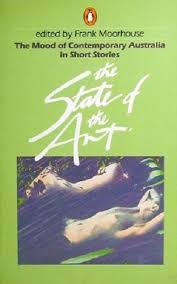
- Free Article: No
- Contents Category: Short Stories
- Review Article: Yes
- Article Title: From Bushie to Narcissus
- Online Only: No
- Custom Highlight Text:
The fact that two major publishing houses have produced anthologies of Australian short stories at about the same time suggests that a discernable market has been perceived, that the short story, in this country, survives fit and healthily enough to command considerable interest. The images that the dust-covers of the two books project, however, could hardly differ more and lead to obvious conclusions about the sectors of the market at which the books are aimed. Kerryn Goldsworthy’s Australian Short
- Book 1 Title: The State of the Art
- Book 1 Subtitle: The mood of contemporary Australia in short stories
- Book 1 Biblio: Penguin, $9.95 pb, 282 pp
- Book 1 Cover Small (400 x 600):

- Book 1 Cover (800 x 1200):

- Book 2 Title: Australian Short Stories
- Book 2 Biblio: J.M. Dent, $9.95 pb, 376 pp
- Book 2 Cover Small (400 x 600):

- Book 2 Cover (800 x 1200):

Stories has a staid, conservative cover featuring a Tom Roberts painting of a stockman rounding up sheep. This was perhaps seen as fitting enough for a collection that ‘reflects the history of the Australian short story’ and it appears that the publishers have gone for predictability with an eye to the schools. Its dullness belies, to a large degree, the contents. In contrast, Frank Moorhouse’s collection of contemporary short fiction The State of the Art is a crisp, cool green and purple featuring an enigmatic photograph of a naked couple. It’s a brilliant cover that has the stylish flourish of a rock album sleeve and is clearly designed to get around town fast. These covers partially reflect past and present emphases in Australian short fiction, the considerable shift in the focus of interest of writers over the years.
In her introduction to Australian Short Stories Kerryn Goldsworthy says that she has tried to ‘steer a middle course between the idio-syncratic and the predictable’. She has avoided presenting a ‘Best of ...’ selection, doubting whether such exists, although perhaps there are dangers of relativism here. A static canon, she argues, is unlikely to exist duringa period of widespread change in the critical perception and judgement of literature.
Despite the expectations created by the cover, Goldsworthy emerges as something of an iconoclast. Having avoided a desire to gather classics (which is not to say that she is not interested in excellence) she has seen one of her tasks as the attempt to shift the focus in short fiction away from male experiences to the experiences of women. This has been accomplished admirably with the inclusion of strikingly empathetic stories not only from women writers but also from men – Frank Dalby Davidson, Hal Porter and Patrick White in particular. She has also recovered from obscurity the neglected Ethel Anderson whose stories foreshadowed the ‘discontinuous narratives’ of Frank Moorhouse. Anderson is a shrewd social observer with a keen eye for human motivation; if a certain depth is lacking in her stories (two are included) this is made up for by their wit, energy and candour. Unfortunately, the desire to gather stories that focus on perceptions of women has allowed the inclusion of a particularly weak story from Peter Cowan.
Another emphasis in constructing this collection has been the desire to choose stories that reflect changing images of Australia. Naturally, a harsh, alien environment tends to dominate the earlier stories by, amongst others, Henry Lawson and Barbara Baynton (whose ‘The Chosen Vessel’ is, in its form, a remarkably inventive story for its time) and this presence weaves through later stories by Katherine Susannah Prichard, Davidson and Alan Marshall. The perception of the land gradually alters until in Moorhouse’s ‘A Person of Accomplishment’ the bush and Aboriginals have become a matter of academic interest and indeed in Peter Carey’s ‘American Dreams’ a country town is no longer fact but fable. It is clearly one of the pleasures of reading an anthology such as this one that it facilitates a varied cook’s tour through Australia’s cultural history – from bush blues to big city blues.
Along the way Goldsworthy has also included a few social realist stories that make their specific points sometimes a little too obviously. The two John Morrison stories, however, are memorable. It is not until you reach the work of Hal Porter (and to a degree Christina Stead) that the brute actuality of physical or social reality withdraws to allow imaginative extravagance and artful playfulness. You arrive at Porter’s abundant talent with a sense of relief at the wonderful marriage of exuberant style with shrewd perception. Porter’s ‘Brett’, the story of a beautiful young female traveller with a dislocated personality, is one of the outstanding stories in this collection and exemplifies the theme of travel that has become so popular in recent short fiction. Of the other contemporary writers 1 was delighted by the stories from Elizabeth Harrower and Morris Lurie. There arc some unexpected inclusions (it’s good to see Elizabeth Jolley) and some surprising exclusions (no Marjorie Barnard); and except for Patrick White’s ‘Down at the Dump’ the stories chosen, as do a few of the authors, differ from those included in H.A. Heseltine’s Penguin selection with which this collection must surely compete.
A number of writers in Goldsworthy’s anthology also appear in The Stale of the Art. They are Lurie, Wilding, Carey, Bail and Moorhouse himself. This collection, as the title suggests, should give a fair idea of what sort of shape the short story is in now and, indeed, on the surface it is a dazzling, engaging and varied collection. Moorhouse is quick to point out in his introduction that he ‘did not seek stories that illustrated types of experience, such as “life on the dole”; my concentration was on the art of story-telling.’ I think that this points towards the success of the collection (it has been praised by reviewers) but also to its limitations. Moorhouse goes on to say that ‘A good short story is like a good conversation, a sexual encounter with a stranger which turns out to be surprisingly good or a beautiful handmade toy.’ This is pretty apt. Most of the stories are sensuous, lively, anecdotal but are rarely engaged on a political or metaphysical level. Indeed there is a narcissistic quality about much of the work, not only in the sense that some of the stories are self- congratulatory exercises in mirrorgazing but also because much of the subject matter suggests that the cult of youth predominates: style is often paramount. It is, in some ways, an undemanding book because many of the stories are concerned with situational mood rather than with ideas or issues. Nevertheless, the book is exceptionally worthwhile and anyone interested in the contemporary short story should read it. Moorhouse has sifted through hundreds of stories and has obviously researched widely to gather this selection. Its freshness is a result of this: many of the stories have appeared previously only in publications that are difficult to obtain and most of the writers have not had stories previously anthologised.
Moorhouse has avoided the work of a number of named ‘master practitioners’ but has neglected to include work from a few substantial authors who have recently published collections: Beverley Farmer, Elizabeth Jolley, Peter Goldsworthy and James McQueen come immediately to mind. Is it because these are not simply ‘mood’ writers? Several authors in this collection however offer stories that have inner pressure, imaginative drive, insight, and have something to say. Outstanding are those by Gerard Windsor, Olga Masters, John Bryson, Damien White, Nicholas Jose, J.M.S. Foster, Morris Lurie, Fay Zwicky and Moorhouse himself who, of all the contributors, is strikingly aware in his writing of an Australian tradition. Several others display a high level of achievement. What the Moorhouse anthology makes particularly apparent, in relation to Goldsworthy’s, is that many fiction writers now are much less concerned with physical environment and social conditions than with states of mind and complex feelings, inwardness. The covers of the two books suitably generalise the situation.


Comments powered by CComment